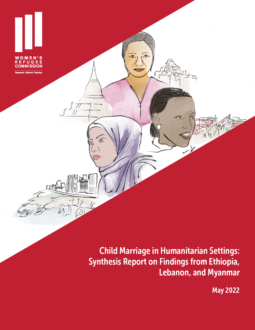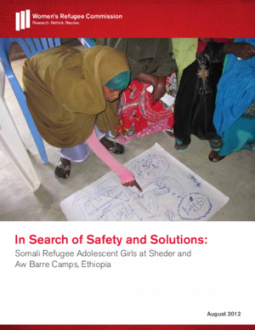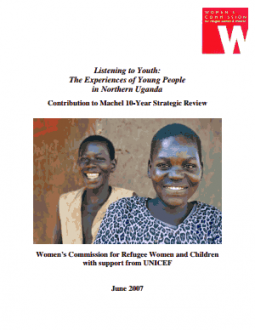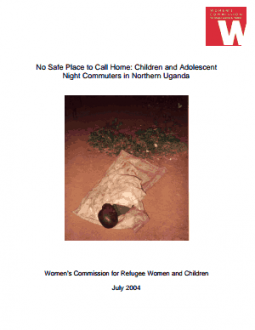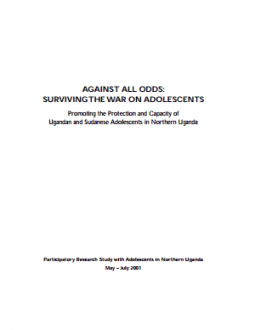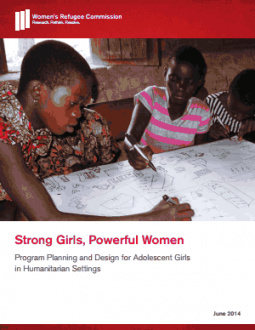
Strong Girls, Powerful Women: Program Planning and Design for Adolescent Girls in Humanitarian Settings
PublishedThis report synthesizes the findings from:
- Desk research and key informant interviews
- In-country assessments from refugee camps in Ethiopia, Tanzania, and Uganda
- Learning to date from pilot programs in three refugee camps in Ethiopia, Tanzania, and Uganda
In most countries, adolescent girls face disadvantages compared to their male peers in family roles, divisions of labor, and access to resources because they are female and young. Even before conflicts erupt or natural disasters occur, adolescent girls’ transition from childhood to adulthood is shaped by rigid expectations that have negative implications for their access to health services, schooling, and other life-shaping opportunities. In conflict and displacement settings, the institutions, systems, and community cohesion that normally support girls’ development, protect them from violence, and uphold their human rights are weakened or destroyed. Family and community structures break down, while traditional and social norms disintegrate, affecting adolescent girls in unique and devastating ways.
Yet, adolescent girls in humanitarian settings should not just be seen as a vulnerable group; girls possess enormous capacity for becoming a source of transformation in their families and communities. Growing evidence supports that investing in girls’ economic and social empowerment can reduce their risks of experiencing violence and is an effective pathway to sustainable development. Likewise, conflict and crisis situations often lead to shifting gender roles that open up possibilities for positive social changes, resulting in an opportunity for gender norms to change for the better.
The Women’s Refugee Commission (WRC) has worked for a number of years on promoting effective economic opportunities for women to mitigate their risk of experiencing gender-based violence. A key finding to emerge from this work was the necessity to undertake a specific initiative on adolescent girls aged 10-16 years old—for whom direct employment may not be age-appropriate, yet building employment-readiness skills is critical. In 2010, a three-year global advocacy project entitled Protecting and Empowering Displaced Adolescent Girls Initiative was launched to find ways to equip adolescent girls in humanitarian settings with skills and resources to transition safely to adulthood and prepare them for developing safe, dignified livelihoods.
In collaboration with implementing partners, the WRC tested promising approaches in adolescent girls’ programming by applying the learning from development contexts in pilot programs in three displacement settings. The initiative explored alternative means of empowerment to protect adolescent girls by establishing safe spaces as portals where displaced girls can build confidence and agency while gaining critical skills for their future livelihoods.
Key Recommendations
- Allocate a sufficient start-up period to allow time for staff training and consultations with girls, and to adjust tools for learning activities. Time must be invested before interventions start to ensure staff can work effectively with girls and tools are developed for girls’ activities.
- Maintain a focus on girls as the primary beneficiaries. Programs for youth or women are mostly attended by adult males or older women, respectively. Level the playing field for girls by centering interventions on girls, and involving them every step of the way.
- Create safe spaces to bring girls together. Public spaces are usually dominated by men and boys. Girls need a space to call their own. Safe spaces can be a platform for building girls’ social networks, knowledge, and skills.
- Build mentorship and leadership models into programs. Girls and communities mutually benefit from mentorship and leadership. When a girl sees herself as a leader or mentor, it can create a positive force for change in her life. Strong networks of girl leaders improve the status of females in the community.
- Integrate programs with economic strengthening activities. Financial literacy and vocational skills training, and practicing savings, should accompany the learning activities for girls. Integrating activities to increase a girl’s economic prospects can lead to improvement in her and her family’s future well-being.
- Ensure programs are developmentally and contextually appropriate. Life skills for younger girls should focus on different issues than for pregnant, married, and parenting girls; for financial literacy skills, help younger girls to practice savings, and older girls to access loans.
- Involve men and boys in programs as partners and allies for changing gender norms. Engaging men and boys without explicit focus on transforming unequal power relations may not be as effective and can even lead to more gender inequality.


